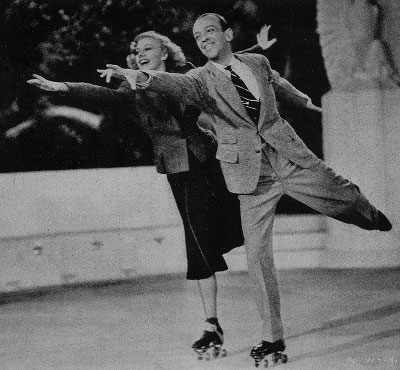 We recently found a photo of Fred Astaire and Ginger Rogers dancing "Let's Call the Whole Thing Off," from the movie Shall We Dance, 1937; yes, on roller skates, but never mind that.
We recently found a photo of Fred Astaire and Ginger Rogers dancing "Let's Call the Whole Thing Off," from the movie Shall We Dance, 1937; yes, on roller skates, but never mind that.
We like the lesson on body lines in this photo—the demonstration that the shape of the body can be pleasing and can add to the beauty of the dance. Notice how Fred and Ginger's leading shape, their right legs, torsos, and arms match almost exactly. Their head positions, gaze, and even their "artful" right hand shapes match. We can't see Ginger's left leg, but let's imagine that their thighs, the angle of their bent knees, and the amount of rotation and consequent relationship of their legs to the floor are all exactly the same.
Why is this important? Balance and symmetry are pleasing to humans. Is it nature or nurture? Surely it is both, and our artistic responses can be surprisingly powerful. We love a graceful curve, a flowing, soaring shape. And the shape of one dancer reinforces that of the other and pushes the effect of the whole to a higher level. Attention to body shape adds so much to the look of our dancing.
When we match shapes, it not only looks good to others; it looks good and feels good to us. By matching your partner's line, you are dancing with him or her, rather than simply doing your own thing somewhere in her proximity. It is a form of visual communication. You are saying, "I see what you are doing, I like it, and I'm with you." "We are one."
Given all this, it is interesting to see what Fred and Ginger are doing with their left arms (or what they are not doing). It pains me to suggest that Fred could ever have left a mistake on film without doing yet another take, but they are not together back there, and he looks a little tired and droopy. Ginger is perky. She feels good, so she looks good. Fred is putting a good face on it, but deep down, maybe it's been a long day.


No comments:
Post a Comment